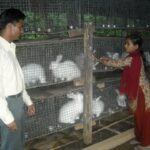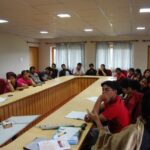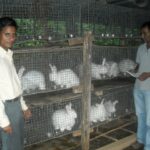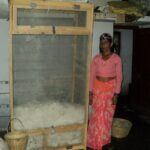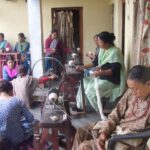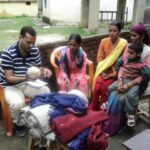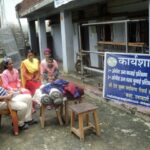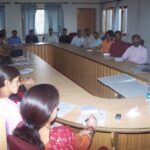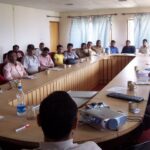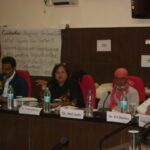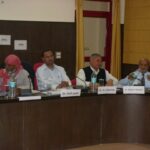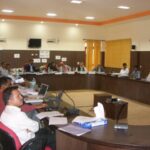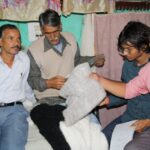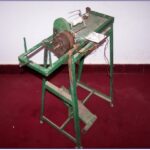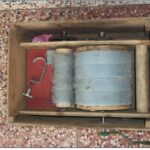COORDINATED PROGRAM FOR DEVELOPMENT OF ANGORA WOOL SECTOR
COORDINATED PROGRAM FOR DEVELOPMENT OF ANGORA WOOL SECTOR TO ENHANCE INCOME AND EMPLOYMENT GENERATION OPPORTUNITIES IN TRIBAL AREAS OF FIVE DISTRICTS OF UTTARAKHAND THROUGH PARTNER NGOs
INTRODUCTION AND BACKGROUND OF THE PROJECT
The hilly regions of Uttarakhand are heavily reliant on agriculture and animal husbandry. However, these areas face challenges posed by difficult terrain and agro-climatic conditions that limit their production potential. Compounded by the decline of traditional sheep rearing due to grazing issues and diminishing pasturelands, there is a demand for alternative solutions, such as angora rabbit farming. This undertaking not only addresses the demand for wool but also elevates clothing quality and rural economic conditions. The propagation of angora rabbit farming in Uttarakhand’s hilly areas is pivotal for fostering economic growth. Presently, agriculture and animal husbandry in these hilly regions yield inadequate economic returns. To invigorate the local economy, it is imperative to diversify through angora rabbit breeding and rearing. The exceptional quality of angora rabbit wool commands significant demand and fetches high prices in the global market. Consequently, angora rabbit farming holds the potential to significantly enhance the economic landscape of Uttarakhand’s hilly regions. The rapid reproduction rate and short generation interval of angora rabbits offer an advantage in terms of swift selection and improvement when compared to other livestock. Applying scientific methodologies to breeding, feeding, management, and wool processing can amplify wool production within angora rabbit units. This project is oriented towards augmenting technical expertise, streamlining input distribution, and enhancing marketing infrastructure, thereby boosting the economic returns derived from angora rabbit breeding.
Over the past several years, angora rabbit breeding has emerged as a substantial income source in hilly regions. It presents a sustainable income avenue for those with limited agricultural land. Notably, Uttarakhand’s hilly areas, spanning altitudes of 4000 to 7000 feet above sea level, are fertile grounds for this enterprise. The confluence of profitability, income generation, employment opportunities, foreign exchange potential, and ecological rehabilitation underscores the urgency for coordinated efforts to promote angora rabbit breeding. Promoting angora rabbit breeding and rearing holds the promise of increased angora wool production. This shift would benefit traditional farmers, women, and unemployed youth. The relatively modest requirements of space, time, and finances associated with rearing angora rabbits make it a manageable endeavour for individuals with minimal training. The rapid reproduction rate of angora rabbits further contributes to their multiplication. The climatic conditions prevalent in Uttarakhand’s hilly regions are conducive to successful angora rabbit breeding. Despite the profitability potential, angora rabbit farming encounters various challenges, including limited access to superior germplasm and an incomplete understanding of economic viability. Insufficient marketing avenues, feed availability, and health considerations further impede progress. Despite commendable efforts by various agencies, these obstacles result in delayed returns for breeders. In response to these challenges, HIFEED has launched a comprehensive project encompassing diverse training programs that cover angora rabbit breeding and rearing, wool production, processing, spinning, and weaving. This project is driven by the objective of empowering women, unemployed youth, and traditional farmers.
Central to the project’s vision is the establishment of decentralized angora rabbit, spinning, and weaving units that resonate with the principles of economic empowerment, particularly within the tribal community. The proposed project entails the establishment of a germplasm resource center, the advancement of breeding practices, comprehensive training provisions, the expansion of rabbit units into households, the establishment of a wool processing facility, and the implementation of a production and marketing program for angora wool products. The overarching aim is to sustainably boost angora rabbit breeding, thereby generating income and employment prospects for farmers, women, and unemployed youth residing in Uttarakhand’s hilly regions. Under the banner of HIFEED’s initiative, the Integrated Angora Rabbit Wool Development Program seeks to enhance angora wool production, amplify marketing efforts, and bolster sales. This undertaking entails training partner NGOs in angora rabbit breeding and rearing, wool production and processing, spinning, and weaving. Moreover, the project focuses on establishing angora rabbit, spinning, and weaving units at the household level in Uttarakhand’s hilly areas. This strategic move aims to catalyze employment opportunities and contribute to the augmentation of family incomes.
AIMS AND OBJECTIVES OF THE PROJECT
1. Embark on the introduction of angora rabbit rearing as a transformative income-boosting endeavour, specifically designed for mountain tribal families dwelling in the picturesque landscapes of Uttarakhand.
2. Immerse participants in comprehensive training initiatives, meticulously covering various dimensions of angora rabbit breeding, rearing, and the intricate art of wool production.
3. Pioneer the establishment of dedicated angora rabbit, spinning, and weaving units at the grassroots level, focusing primarily on the hilly and tribal regions.
4. Nurture strategic partnerships with proficient Non-Governmental Organizations (NGOs) to harmonize the seamless execution of the project across five distinct districts within the scenic expanse of Uttarakhand.
5. Engineer innovative rabbit feed solutions sourced from local elements while meticulously instituting a well-structured buy-back mechanism, facilitating the seamless procurement of wool, yarn, and resultant merchandise.
6. Efficiently oversee, monitor, and assess the integrated angora program’s on-ground operations, meticulously executed by the collaborative efforts of participating NGOs, thus ensuring the program’s efficacy and ultimate success.
COMPONENTS AND ACTIVITIES OF THE PROJECT
1. Promote angora rabbit rearing to supplement the income of mountain tribal families in Uttarakhand.
2. Deliver comprehensive training and technical support to angora rabbit breeders, Self-Help Groups (SHGs), extension workers, and collaborating Non-Governmental Organizations (NGOs) across various dimensions.
3. Forge partnerships with NGOs to establish angora rabbit wool production units at the household level, ensuring accessibility within local communities.
4. Strengthen the capacity of the high-yielding angora rabbit germplasm resource center, prioritizing quality breeding.
5. Elevate research and development efforts in areas of health care, disease control, nutrition, and feed formulation tailored to angora rabbits.
6. Execute scientific breeding, rearing, and record management protocols to enhance the overall production of angora rabbits.
7. Design and implement improved packages of practices for breeding, feeding, disease control, and processing, ensuring optimal results.
8. Collaborate with community and NGO partners to establish a dedicated Common Facility Centre (CFC) for efficient wool processing.
9. Explore environmentally conscious alternatives such as bamboo for cost-effective housing and cage-making techniques.
10. Erect a dedicated designing center aimed at facilitating product development and diversification.
11. Upgrade traditional machinery and explore the use of vegetable and natural dyes to elevate the quality of end products.
12. Develop efficient techniques for managing manure and compost, aligning with sustainable practices.
13. Forge a comprehensive network for raw angora wool, blended yarn, and finished product production and marketing, anchoring a sustainable value chain.
TARGET AREA OF THE PROJECT
The project was strategically centred on a specified target area, encompassing rural communities within five tribal districts of Uttarakhand: Tehri Garhwal, Uttarkashi, Chamoli, Dehradun, and Pithoragarh. Its primary goal was to introduce angora rabbit rearing as a practical and sustainable means of income generation for tribal families living in the mountainous regions of these districts.
TARGET GROUPS AND BENEFICIARIES OF THE PROJECT
The primary recipients of the project’s benefits were low-income families within tribal communities, situated in the five districts of Uttarakhand, namely Tehri Garhwal, Uttarkashi, Chamoli, Dehradun, and Pithoragarh.
FUNDING PARTNER OF THE PROJECT
The funding for the project was provided by the Department of Science & Technology (DST), Ministry of Science & Technology, Government of India, New Delhi.
SANCTIONED BUDGET OF THE PROJECT
The Department of Science & Technology (DST) sanctioned the Angora Wool Development Project in 2009, under the sanction order No. SP/TSP/055/2007 dated 30.03.2009. The total budget allocated by DST for three years to HIFEED was Rs. 20,75,000.00. In addition, to implement the project in the five districts of Uttarakhand, DST also sanctioned a total amount of Rs. 2,19,55,500.00 for three years to 13 project partners and coordinating agency HIFEED.
OUTCOMES AND ACHIEVEMENTS OF THE PROJECT
The Coordinated Program for Development of the Angora Wool Sector has yielded notable outcomes and achievements as outlined below:
1. The program has successfully established 390 angora rabbit units, alongside 390 spinning and 390 weaving units at the household level in hilly and tribal regions spanning five districts of Uttarakhand, facilitated through a network of Partner NGOs.
2. Thorough training and technical support have been diligently provided to angora rabbit breeders, self-help groups (SHGs), extension workers, and NGOs, covering a range of aspects including angora rabbit breeding and rearing, wool processing, spinning, weaving, knitting, designing, and dyeing.
3. Significant enhancement has been made to the high-yielding angora rabbit germplasm resource center, ensuring the provision of premium-quality angora rabbits to beneficiaries.
4. Rigorous development of scientific and meticulously planned packages of practices has taken place, spanning vital areas such as breeding, rearing, feeding, disease control, treatment, record management, and proficient techniques in production and processing.
5. Substantial reinforcement has occurred in research and development initiatives, focusing on essential domains like healthcare, disease diagnosis and control, nutrition, and the formulation of balanced feed using locally available raw materials.
6. A pivotal Common Facility Centre (CFC) has been strategically established, operating at both the community and NGO levels, facilitating diverse processes including carding, blending, spinning, weaving, knitting, and the meticulous processing of raw angora wool into intricate hand-crafted finished products.
7. A dedicated design center has been inaugurated, serving as a hub for product development, design refinement, and the diversification of product offerings.
8. In alignment with the promotion of sustainable development practices, the program has innovated cost-effective techniques for housing and cage construction using bamboo and other sustainable alternatives, coupled with efficacious methodologies for efficient manure and compost management.
9. Significant advancements have been achieved in the enhancement of traditional machinery and equipment, complemented by dynamic research and development endeavours centred around vegetable and natural dye technologies.
A comprehensive and well-connected network for production and marketing, bolstered by efficient buy-back mechanisms for raw angora wool, angora wool blended yarn, and meticulously hand-crafted finished angora woolen products, has been meticulously established.





